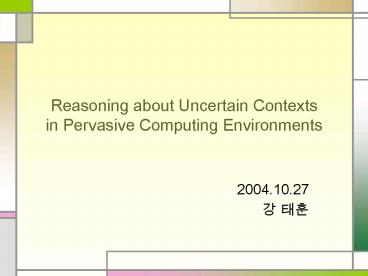Reasoning about Uncertain Contexts in Pervasive Computing Environments - PowerPoint PPT Presentation
1 / 18
Title:
Reasoning about Uncertain Contexts in Pervasive Computing Environments
Description:
Context Provider Lookup Service. Enables Context Providers to advertise ... Number of other people in the room. The identities of the other people in the room ... – PowerPoint PPT presentation
Number of Views:27
Avg rating:3.0/5.0
Title: Reasoning about Uncertain Contexts in Pervasive Computing Environments
1
Reasoning about Uncertain Contextsin Pervasive
Computing Environments
- 2004.10.27
- ? ??
2
Overview
- Introduction
- Context Infrastructure - Gaia
- Uncertainty Model
- ConChat
- Reasoning Mechanisms
- Examples
- Conclusion
3
Introduction
- Context-Aware systems can't always identifythe
context precisely - Need support for handling uncertainty
- Uncertainty Model
- Context Predicate
- Confidence Value
- Reasoning Mechanisms
- Probabilistic Logic
- Fuzzy Logic
- Bayesian Networks
- Context Infrastructure - Gaia
4
Context Infrastructure - Gaia
- Context Providers
- Sensors or other data sourcesof context
information - Context Synthesizers
- Get sensed contextsfrom various Context
Providers - Deduce higher-level or abstract contexts
- Provide deduced contexts to other agents
- Context Consumers
- Entities (Context-Aware applications)
- Get different types of contexts from Context
Providers or Context Synthesizers
5
Context Infrastructure - Gaia
- Context Provider Lookup Service
- Enables Context Providers to advertise what they
offer - Enables agents to find appropriate Context
Providers - Context History Service
- Lets agents query for past contexts
- Ontology Server
- Maintains the ontologies
6
Uncertainty Model
- Context Predicate
- Simple, uniform representation for different
kinds of contexts - Subject-Object(ContextType (ltSubjectgt,
ltObjectgt))or Subject-Verb-Object(ContextType(ltSu
bjectgt, ltVerbgt, ltObject gt)) - ex. location(jeff, in, room 3105)
activity(room 3102, meeting) - Comparison operator(, gt, lt), Boolean
operations(And(?), Or(?), Not()) ,
Quantification(?, ?) is possible - ex. Sound Level(dB, gt, 60) Environment
Lighting(Room 3234, Is, Off) ? Environment
Lighting(Room 3234, Is, Dim) Environment
Lighting(Room 3234, Is, Off ? Dim) ?Location
Y Context(Location, Chris, In, Y)
7
Uncertainty Model
- Confidence Value
- Measures the probability or the membership value
of the event - Attaching between 0 and 1 to predicates
- ex. prob(location(carol, in, room 3233)) 0.5
8
ConChat
- A Context-Aware chat program
- Let users query their chat partner's context
through a side channel - Context Model
- Context Predicate
- Architecture for
Context-Aware Chat
9
ConChat
- Sharing contextual information
- Party location
- Number of other people in the room
- The identities of the other people in the room
- Room temperature, light, and sound
- Other applications and devices running in the
room - User's mood (such as happy, sad, or excited)
- User's status (such as "on the phone" or "out to
lunch") - Activity in the room (such as a meeting, lecture,
or presentation) - Activity
- first-order predicate calculus that it evaluates
to determine the room's activity. - ex. people(Room 2401, gt, 3) ?
Application(PowerPoint, Is, Running) gt Room
Activity(2401, Is, Presentation) people(Room
2401, gt, 3) ? NOT Application(PowerPoint, Is,
Running) gt RoomActivity(2401, Is, Meeting)
10
ConChat
- Semantic conflicts
- Naming conflicts
- Confounding conflicts
- Scaling conflicts
- ex. AppearsText("Football") ?
Location-Country(Sender, In, Canada ?USA) ?
Location-Country(Receiver, In, France ? Germany ?
UK) ? Tag-With(American Football)
Currency(Sender, Is, X) ? AppearsMoney(X, N) ?
Currency(Receiver, Is, Y) ? (X ? Y) ?
TagWith(ConvertCurrency(N, X, Y) )
11
ConChat
- ConChat user
interface
12
Reasoning Mechanisms
- Probabilistic Logic
- Lets us write rules that reason about events'
probabilities in terms of the probabilities of
other related events - ex. prob(X, Y, union, P) - prob(X, Q), prob(Y,
R), disjoint(X, Y), (P is Q R) - ? Pr(X ?Y) Pr(X) Pr(Y) if X and Y are
disjoint events - Fuzzy Logic
- Capturing and representing imprecise notions
(such as "tall", "trustworthy" and "confidence")
and reasoning about them - Confidence values represent degrees of membership
13
Reasoning Mechanisms
- Bayesian Networks
- Directed Acyclic Graphs
- Each value corresponds to a certain context
predicate - Rootnodes representthe information to be deduced
- Leaves are sensed information
- Intermediate nodes are subgoals that are
helpfulto the deduction process
14
Structure of an entity
15
Examples
- Uncertainty in sensing context
- Two factors contribute to uncertainty in a
person's location - The uncertainty of whether the badge is actually
in the room - Using a sensor fusion procedure
- The uncertainty of whether the people actually
carry the badge - Assign a probability value to the event of a
person actually having the badge in hand - ex. Prob (location(X, in, Y)) Prob (device
associated with person is in Y) Prob (device
is actually with person X) - ? Use in Authentication
16
Examples
- Inferred context
- Authentication service
- Confidence Value V1, V2,..., V
- ? Vnet 1 - (1 - V1)(1 - V2) ...(1 - Vn)
- Room activity
- Bayesian inferencing algorithm
- Calculates the conditional probability
distribution of the Activity node given the
states of the leaf nodes - ex. activity(room 2401, meeting) ? Confidence
value 0.6 activity(room 2401, presentation) ?
Confidence value 0.4 activity(room 2401,
idle) ? Confidence value 0.9
17
Examples
- Applications' use of uncertain context
information - Access Control
- ex. CanAccess(P, display) -
ConfidenceLevel(authenticated(P), C), C gt 0.7,
Prob(activity(2401,cs 101 presentation), Y), Y gt
0.8, possessRole(P, presenter)
18
Conclusion
- Key Factor
- Uncertainty Model
- Context Predicate
- Confidence Value
- Reasoning Mechanisms
- Probabilistic Logic
- Fuzzy Logic
- Bayesian Networks
- Meaningful in understanding Context-Aware































